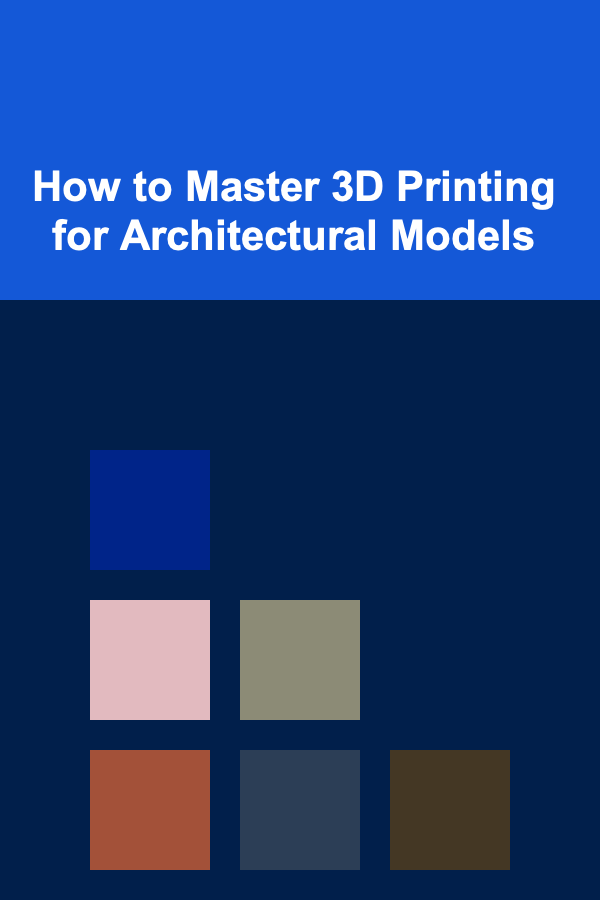
How to Master 3D Printing for Architectural Models
ebook include PDF & Audio bundle (Micro Guide)
$12.99$10.99
Limited Time Offer! Order within the next:

The integration of 3D printing into architectural design is rapidly transforming the way architects and designers approach their work. With its ability to quickly create accurate, intricate models, 3D printing has become a crucial tool in the architectural field. This article aims to guide architects, students, and design enthusiasts through the process of mastering 3D printing for architectural models, covering the tools, techniques, and considerations involved in the process. Whether you are new to the concept or have some experience, this guide will provide comprehensive insights on how to leverage 3D printing for architectural visualization, prototyping, and presentations.
Understanding the Basics of 3D Printing in Architecture
Before delving into the technical aspects of 3D printing for architectural models, it's essential to understand what 3D printing is and how it works in an architectural context.
What is 3D Printing?
3D printing, also known as additive manufacturing, is the process of creating three-dimensional objects from a digital model. Unlike traditional subtractive manufacturing techniques that involve cutting away material, 3D printing builds objects layer by layer. In architecture, this method allows designers to turn digital models into physical representations with high precision.
Benefits of 3D Printing in Architecture
- Rapid Prototyping: Architects can quickly create physical models of their designs to evaluate form, structure, and space.
- Enhanced Visualization: 3D-printed models provide a tangible and accurate representation of architectural ideas, improving the understanding of scale and proportions.
- Customization: Architects can experiment with complex forms, custom details, and even interactive elements that would be difficult to achieve with traditional model-making techniques.
- Cost-Effective for Complex Models: 3D printing can be a more cost-effective option for creating complex models, especially when compared to handcrafting detailed prototypes.
- Sustainability: Since 3D printing uses only the necessary material and can reduce waste, it can be considered a more sustainable method of model-making.
Choosing the Right 3D Printer for Architectural Models
The choice of 3D printer is one of the most important considerations when using this technology for architectural models. Several factors will influence your decision, including the size of the models, the level of detail required, and your budget.
Types of 3D Printers
- Fused Deposition Modeling (FDM): FDM is the most common type of 3D printer used in architectural model-making. It works by extruding a filament of material (usually plastic) through a heated nozzle and layering it on the build platform. FDM printers are affordable, relatively easy to use, and suitable for basic architectural models.
- Stereolithography (SLA): SLA printers use ultraviolet light to cure a liquid resin into solid layers. SLA printers produce high-quality, detailed models with smoother surfaces compared to FDM printers. These printers are ideal for producing smaller, more intricate models, although they are typically more expensive.
- Selective Laser Sintering (SLS): SLS printers use lasers to fuse powdered materials, such as nylon or metal, layer by layer. These printers are capable of producing highly detailed and durable models, but they are typically more expensive and require more expertise to operate.
- Multi-Jet Fusion (MJF): MJF technology uses a combination of powder material and liquid binding agents, offering both high resolution and durability. This type of printer is great for larger-scale architectural models but comes with a higher price tag.
Key Considerations When Choosing a Printer
- Build Volume: The size of the print bed determines the maximum size of your model. Consider the dimensions of your architectural models before selecting a printer.
- Resolution: The level of detail your printer can achieve is crucial for creating accurate models, especially for intricate designs.
- Material Options: Different printers offer different materials (plastics, resins, metals), so choose one that suits your project requirements.
- Software Compatibility: Make sure the printer is compatible with the 3D modeling software you use, such as Rhino, AutoCAD, or SketchUp.
Preparing Your 3D Model
Once you've chosen your 3D printer, the next step is to prepare your digital architectural model for printing. This involves converting the model into a format that the 3D printer can understand and ensuring that the design is optimized for printing.
3D Modeling Software
Architects typically use specialized software to create 3D models, including:
- AutoCAD: A widely used drafting tool that allows precise architectural modeling.
- Rhino: A powerful 3D modeling software with a focus on free-form surfaces, ideal for complex architectural designs.
- SketchUp: Known for its ease of use, SketchUp is popular for creating basic models and conceptual designs.
- Revit: A BIM (Building Information Modeling) software that can be used for architectural design and documentation.
These software programs allow you to create detailed digital models, which can then be exported as 3D printable files. The most common file formats for 3D printing are:
- STL (Stereolithography): The most common file format for 3D printing, used for both FDM and SLA printers.
- OBJ: A 3D file format that retains color and texture information, often used for more detailed models.
- AMF (Additive Manufacturing File Format): A newer format that supports color, material properties, and texture mapping.
Optimizing Your Model for 3D Printing
Before printing, your 3D model should be optimized to ensure a smooth printing process:
- Check for Errors: Ensure that your model has no open edges, holes, or non-manifold geometry (areas that can't be printed). Software like Meshmixer or Netfabb can automatically check and fix such errors.
- Consider Support Structures: For complex models with overhangs or intricate details, support structures may be required. These are temporary elements that are printed alongside your model to prevent collapse. Ensure that your software automatically generates these supports or add them manually.
- Optimize for Print Speed and Material Usage: Larger models or highly detailed prints may take longer to print and use more material. Consider simplifying your model or reducing the resolution for non-essential details to reduce print time and material waste.
Printing the Architectural Model
With your model prepared, it's time to start printing. The printing process involves the following steps:
Loading the Model
Most 3D printers use proprietary software to manage the printing process. Once your model is loaded into the printer's software, you can adjust print settings, such as layer height, print speed, and infill density.
Printing Process
- Start the Printer: After loading the settings, initiate the printing process. Depending on the printer and model size, this may take anywhere from a few hours to several days.
- Monitor the Print: It's essential to monitor the print as it progresses. Problems like warped surfaces, print failures, or material issues can occur, so it's a good practice to check the print periodically.
Post-Processing
After the model is printed, post-processing may be necessary. This can involve:
- Removing Support Structures: If supports were used during printing, they will need to be carefully removed.
- Sanding and Smoothing: For models printed with FDM printers, sanding may be required to remove visible layer lines and smooth the surface.
- Painting or Detailing: Many architects choose to paint or add additional details to their models to enhance their appearance. This can be done with spray paints, markers, or other techniques.
Applications of 3D Printing for Architectural Models
The potential applications of 3D printing in architecture are vast. Here are a few ways it is being used:
Conceptual Models
3D printing is an excellent way to quickly visualize conceptual designs. Whether it's a small-scale study model or a larger presentation model, 3D printing allows architects to bring their ideas to life in a way that traditional methods can't.
Structural Models
With its precision, 3D printing allows architects to create models that showcase the structural aspects of a design. These models can include accurate representations of walls, beams, columns, and other elements, helping engineers and clients understand how the building will perform structurally.
Urban Planning Models
For urban planning and city-wide developments, 3D printing is an invaluable tool. Large-scale models of entire neighborhoods or districts can be printed to examine how new developments will fit into existing spaces.
Custom Components and Details
3D printing allows architects to create custom details and components that would be challenging to fabricate using traditional methods. Whether it's a unique façade element or a custom interior design feature, 3D printing opens up possibilities for intricate detailing.
Challenges and Limitations of 3D Printing for Architectural Models
While 3D printing offers numerous advantages, it also comes with its own set of challenges and limitations.
Material Limitations
While there are many materials available for 3D printing, not all of them are suitable for architectural models. For instance, the most commonly used 3D printing materials (like PLA or ABS) may not replicate the textures or finishes typically found in construction materials.
Size Limitations
Although 3D printers are available in various sizes, printing large-scale models may require multiple parts to be printed and assembled, which can lead to seam lines or misalignment issues.
Print Quality
The quality of the print can be affected by the printer's resolution and the type of material used. Lower resolution prints may not capture fine details, and low-quality printers may result in rough surfaces.
Conclusion
Mastering 3D printing for architectural models requires a combination of technical knowledge, creativity, and an understanding of the printing process. By choosing the right 3D printer, optimizing your models, and effectively utilizing 3D printing software, you can produce high-quality architectural models that enhance your design workflow. While there are challenges to be aware of, the potential benefits of using 3D printing for architecture---from rapid prototyping to intricate detailing---make it a valuable tool in the modern architect's toolkit. By embracing this technology, architects can push the boundaries of design, presentation, and visualization, revolutionizing the way buildings and spaces are conceptualized and created.
Reading More From Our Other Websites
- [Home Maintenance 101] How to Keep Your Home's Walls and Ceilings in Good Condition
- [Home Maintenance 101] How to Prevent and Treat Rust in Your Home's Fixtures and Appliances
- [Home Staging 101] How to Stage a Home for the Winter Market
- [Home Cleaning 101] How to Keep Your House Smelling Fresh All Day Long
- [Personal Investment 101] How to Start Investing in Commodities for Beginners
- [Organization Tip 101] How to Collect and Analyze Event Data for Insights
- [Home Storage Solution 101] How to Organize Jewelry and Makeup with Smart Storage Organizers
- [Organization Tip 101] How to Share Antique Knowledge with the Next Generation
- [Home Budget 101] How to Make Extra Income from Your Home to Boost Your Budget: Side Hustles for Homeowners
- [Home Cleaning 101] How to Use Vinegar and Baking Soda for Home Cleaning

Developing and Selling Deep Learning Models for Profit
Read More
How to Incorporate LED Lighting into Your Home Decor
Read More
How to Organize Your Bath Products for a Streamlined Routine
Read More
Cooking with the Seasons: A Guide to Seasonal Vegetables
Read MoreHow to Track Home Improvement Costs in Your Insurance Expense Tracker
Read More
How to Handle Difficult Questions from Journalists: A Comprehensive Guide
Read MoreOther Products

Developing and Selling Deep Learning Models for Profit
Read More
How to Incorporate LED Lighting into Your Home Decor
Read More
How to Organize Your Bath Products for a Streamlined Routine
Read More
Cooking with the Seasons: A Guide to Seasonal Vegetables
Read MoreHow to Track Home Improvement Costs in Your Insurance Expense Tracker
Read More